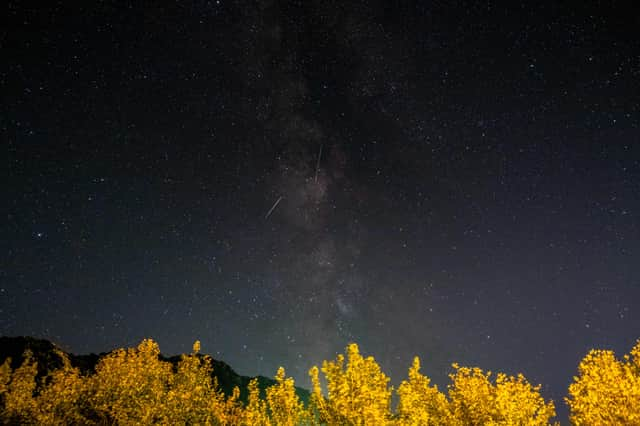Orionid meteor shower: where to see them in the UK, when is the peak - how to see shooting stars


The Orionids could put on a spectacular celestial display later this month (21 October).
Gaze upwards and - if the weather remains clear - you could be treated to up to 70 shooting stars an hour as the Earth intersects the orbit of Halley’s Comet.
Advertisement
Hide AdAdvertisement
Hide AdHere is everything you need to know about the spectacle, including how to see the meteor shower.
What is the Orionid meteor shower?
The Orionid meteor shower is an annual meteor shower that occurs in October, and is associated with Halley's Comet, one of the most famous comets in our solar system.
The shower is caused by the Earth passing through the debris left behind by Halley's Comet during its numerous orbits around the Sun. We haven’t seen the comet itself since 1986, but our planet passes through this orbit twice a year, bringing the Orionids in October, and the Eta Aquarids in May.
When these tiny particles, often no larger than grains of sand, enter the Earth's atmosphere, they burn up due to friction with the air, creating bright streaks of light known as meteors or "shooting stars."
Advertisement
Hide AdAdvertisement
Hide AdThe Orionids get their name because they appear to radiate from a point in the sky near the constellation Orion, specifically from the area around Orion's sword.
When is the best time to see them?
The meteors have actually been visible in the night sky since roughly 2 October, but they typically reach their peak activity in the second half of October, around 20 to 22 October 20th to 22nd. During this time, observers can see an increased number of meteors in the night sky.
On a typical year, the Orionids produce around 10 to 20 meteors per hour during their peak. However, this rate can vary from year to year and may be influenced by factors such as the moon's brightness and the amount of debris in the comet's path.
What's the best way to see them?
Thankfully, budding stargazers need not splash out on expensive tech to see the Orionids; they will be visible with the naked eye.
Advertisement
Hide AdAdvertisement
Hide AdTo observe the Orionid meteor shower, find a location away from city lights with a clear view of the night sky. The best time to watch is typically after midnight when the radiant point (near Orion) is higher in the sky.
Patience is key, as meteor showers involve periods of inactivity followed by brief bursts of activity. It can take some time to spot meteors, so bring a comfortable chair or blanket and allow your eyes to adjust to the darkness.
The brightness of the moon can affect the visibility of meteor showers. If the moon is near full or very bright, it may wash out fainter meteors, reducing the overall visibility of the shower. Thankfully, the moon will only be about a quarter "full" around the peak of the meteor shower in 2023.
When will the next meteor shower be?
Don’t worry too much if you don’t get outside or it’s too cloudy where you live. The next meteor shower visible from the UK will be the Leonids, reaching their peak across the evening of 17 November.
If you’re after the Orionids specifically, you’ll have to wait until 21 October of next year.
Comment Guidelines
National World encourages reader discussion on our stories. User feedback, insights and back-and-forth exchanges add a rich layer of context to reporting. Please review our Community Guidelines before commenting.
